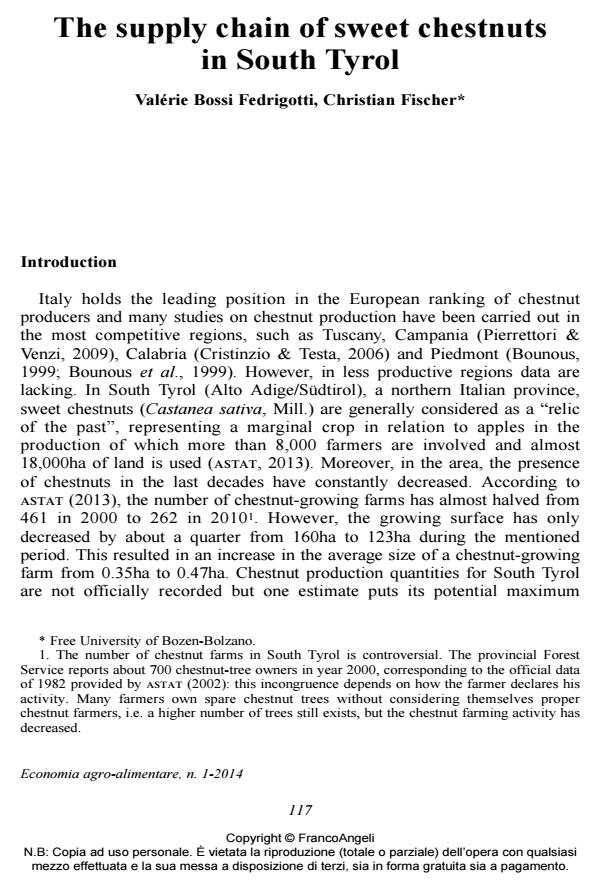The supply chain of sweet chestnuts in South Tyrol
Titolo Rivista ECONOMIA AGRO-ALIMENTARE
Autori/Curatori Valérie Bossi Fedrigotti, Christian Fischer
Anno di pubblicazione 2014 Fascicolo 2014/1
Lingua Italiano Numero pagine 21 P. 117-137 Dimensione file 281 KB
DOI 10.3280/ECAG2014-001006
Il DOI è il codice a barre della proprietà intellettuale: per saperne di più
clicca qui
Qui sotto puoi vedere in anteprima la prima pagina di questo articolo.
Se questo articolo ti interessa, lo puoi acquistare (e scaricare in formato pdf) seguendo le facili indicazioni per acquistare il download credit. Acquista Download Credits per scaricare questo Articolo in formato PDF

FrancoAngeli è membro della Publishers International Linking Association, Inc (PILA)associazione indipendente e non profit per facilitare (attraverso i servizi tecnologici implementati da CrossRef.org) l’accesso degli studiosi ai contenuti digitali nelle pubblicazioni professionali e scientifiche
Italy is the largest producer of chestnuts in Europe and its most advanced and chestnut-oriented regions are Tuscany, Calabria, Campania and Piedmont. This study, however, focuses on the chestnut supply chain in South Tyrol (Alto Adige/Südtirol), a northern province where chestnuts are currently of minor importance in relation to other crops, such as apples and grapes. Nevertheless, a small number of chestnut farmers still keep the historically-rooted tradition alive. A detailed survey of the chestnut supply chain, involving interviews with 138 producers, 49 distributors and 272 consumers revealed the strengths and weaknesses of the local niche market. Moreover, separate analysis of four sub-regions revealed that significant production and marketing heterogeneity exists. In orchard management, as well as in purchasing and consumption habits, three different local characteristics were identified: (i) around Merano commercial chestnut production and direct sales; (ii) around Bressanone chestnut wood production; and (iii) in the Valle Isarco the use of "chestnut trails" as spare time activities. New regional development strategies will therefore have to take into account geographical disparities when introducing innovations into this traditional agricultural activity.
Parole chiave:Chestnuts, market, supply chain, South Tyrol
Jel codes:Q13
- Public Preferences for Farmed Landscapes: the Case of Traditional Chestnut Orchards in South Tyrol Valérie Bossi Fedrigotti, Stefania Troiano, Christian Fischer, Francesco Marangon, in European Countryside /2020 pp.99
DOI: 10.2478/euco-2020-0006
Valérie Bossi Fedrigotti, Christian Fischer, The supply chain of sweet chestnuts in South Tyrol in "ECONOMIA AGRO-ALIMENTARE" 1/2014, pp 117-137, DOI: 10.3280/ECAG2014-001006